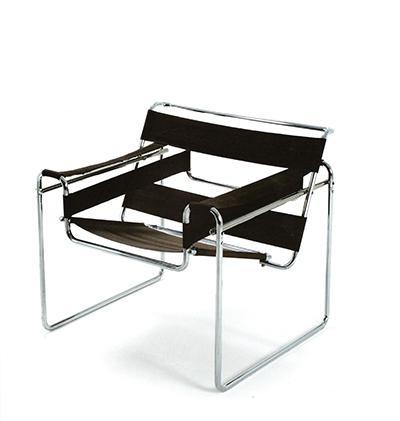
Bryn Mawr, the Bauhaus, and Breuer
In 1936, modernist architect Marcel Breuer designed a suite of bedroom furniture for Rhoads Hall. 这种不太可能的搭配是最近一个由学生策划的展览的主题.
当我搬进我在布林莫尔的第一间宿舍时,我觉得我好像进入了历史. I could almost feel the presence of previous students who had lived in that very same room on the third floor of Brecon. When I packed up my last dorm room in Denbigh last spring, I realized I now understand the history of this place much more deeply than I ever would have imagined.
As part of a requirement for my museum studies minor, in the spring semester of my sophomore year, I pursued an experiential learning opportunity in Special Collections where I researched the furniture and design history of the College and even curated an exhibition of my own.
Carrie Robbins, the curator for art and artifacts, suggested that I organize an exhibition on Marcel Breuer, 1936年为罗兹设计卧室家具的包豪斯建筑师. 该展览将与2019年包豪斯学院百年庆典同时举行. Art and design museums around the world were honoring this anniversary with exhibitions on the legacy of the Bauhaus—and Bryn Mawr was no exception.
在遇到布鲁尔为罗兹设计的家具时——一套由椅子组成的家具, desk, bookshelf, and mirror—I was honestly underwhelmed; it looked like regular dorm furniture. Once I began learning about it, 我意识到,正是这套装置的简单使它如此与众不同.
Bauhaus and Beyond
The story of Breuer’s furnishing of Rhoads is a poignant reminder of the changing form of Bryn Mawr’s campus and a tangible example of how Bryn Mawr’s history is intertwined with the greater community. The furniture for Rhoads marked an important moment in Breuer’s artistic oeuvre and a significant shift in the development of modern furniture. It also affected the generations of Mawrters who lived in Rhoads with the furniture for almost 60 years.
我的研究始于著名的德国包豪斯设计学院. Founded by Walter Gropius in 1919, 包豪斯体现了魏玛德国的超前思维精神. 华丽的细节工作被拒绝,赞成简化使用的颜色,线条和材料.
Breuer, born in 1902, was a student at the Bauhaus and was considered such a visionary that he was invited back to be the head of the carpentry shop. 在那里,他设计了他的第一把著名的椅子:B3型“瓦西里”椅子. Breuer’s revolutionary use of tubular steel construction with this chair let people feel as though they were “sitting on a cloud.”
The rise of the Nazis brought an end to the Bauhaus—newly deemed a bastion of “degenerate art”—in 1933. The students and staff, many of whom were of Jewish descent, including Breuer, fled Germany and resettled around the world, spreading the design principles of the Bauhaus. Breuer and his mentor, Gropius, settled in England. My own great-grandparents had also fled Europe because of their Jewishness in the early 20th century, 学习包豪斯的历史让我觉得自己和布鲁尔有了联系.
Each leg of Breuer’s journey influenced his design, as he learned and experimented with different materials. While working for the Isokon architecture firm in London, 他开始将他早期的设计从钢管转变为胶合板, creating the award-winning Isokon Long Chair, 以及其他探索胶合板可能性的家具.
Breuer at Bryn Mawr
布鲁尔在胶合板上的实验伴随着他来到了布林茅尔. After only two years in England, Breuer and Gropius relocated again to America in 1937, 他们都接受了哈佛大学设计研究生院的教学职位. 同年,布鲁尔接受了他在美国的第一个设计委托.S., the dorm furniture for Rhoads Hall.
Rhoads was built in the Collegiate Gothic style, complete with ornate stone detailing, magnificent wrought-iron windows, and the overall feel of a castle. 这个新宿舍正好与校园融为一体,与附近的古德哈特大厅和旧图书馆很好地结合在一起. 那么,为什么这些现代主义家具是为罗兹设计的呢?
In the exhibition, I asked: How is it that the plain, rectilinear Park Science building and romantic, castle-like Rhoads were built in the same year (1937)? And furthermore, isn’t it odd that the furniture for Rhoads, with its modernist simplicity, seems better suited for the interior of Park than Rhoads? These architectural and design juxtapositions reveal an ongoing identity crisis; the College wanted to maintain its Collegiate Gothic image but at the same time be relevant and contemporary.
罗兹的陈设委员会——由厅长组成, a few involved alumnae, 两名大学生代表开始在百货商店寻找家具, looking for a readymade set, but to no avail. They then had two sets prototyped. 第一个被抛弃了,用委员会的话说,因为它“没有睫毛”.” The second set was Breuer’s design.
Breuer’s chair for Rhoads is of a cutout design: the sides of the chair punched out like puzzle pieces from a sheet of plywood. Bryn Mawr办公桌弯曲的桌腿是胶合板强度的证明. 普通木材会沿着弯曲处裂开,而胶合板可以弯曲成任何形式. 总的来说,你可以从这套简单的设计中看到包豪斯的影响. There are no frills or hard edges. Every form has a function.
An Unlikely Alliance
How is it that Marcel Breuer even came under consideration for a commission at Bryn Mawr College? The Bryn Mawr alumnae network, of course. One of the alumnae serving on the furnishing committee was Elizabeth Moore Cameron (née Elizabeth Ripley Moore), class of 1928. Her sister, Dorothea May Moore, class of 1915, 布鲁尔在哈佛大学的时候在哈佛医学院教书, and Moore’s correspondence with her sister makes clear that she was the point of introduction between the designer and the Bryn Mawr furnishing committee.
In Breuer’s first proposal for the set, he designed a highly unconventional chair whose seat and back were made up entirely of wooden dowels. 他试图说服委员会在这种新主席身上碰碰运气, writing: “The chair will seem a little strange at first, as its technique and form are quite new.” He suggested that students could personalize their chairs by braiding a thin rope between the rungs. When the committee received the prototype, it was quickly rejected as too uncomfortable; they wanted a chair that would be comfortable without any added cushioning. Breuer then replaced the rungs with a solid seat and back. It is ironic that many alumnae described to me how uncomfortable the chairs were; indeed, 使用中的椅子的照片中经常有枕头!
布鲁尔最初的方案还包括一个挂在墙上的书架草图, instead of standing on the ground. The alumnae of the furnishing committee wrote that they were “delighted with your [Breuer’s] suggestion about bookcases, but we have been unable to convert the undergraduates who are vigorously opposed to having bookshelves they cannot move around.” Breuer assured them that they would appreciate the extra floor space that these hanging shelves would provide in such small rooms. He suggested that the bookshelves hang on metal hooks to allow them to be hung up in any part of the room. 委员会同意了这一点,布鲁尔提出的想法占了上风. For any alumnae reading this who lived with Breuer’s furniture in Rhoads but did not have the luxury of moving their bookshelf around the room, this is likely because, 随着家具的老化和金属悬挂机构的断裂, 学院设施的工作人员把书架直接固定在墙上.
In Situ
Ultimately, Bryn Mawr commissioned 120 sets of Breuer’s plywood furniture for both wings of Rhoads. When the dorm opened in 1939, 他的家具受到了校友和学生们的赞扬, even those who had had misgivings, calling it “heavenly” in this very publication, the Alumnae Bulletin.
布鲁尔的家具从1939年开始在罗兹使用,直到1999年大厅翻修. 60年来,马特斯一直与布鲁尔一起生活,并将自己的想法融入布鲁尔的设计作品中. I find it amazing that, despite how much everything else changes, 在罗兹房间的照片中,这些家具看起来就像家一样. His timeless designs accommodate the delicate tea sets of the 1940s as well as the electric water boilers of the 1980s.
到20世纪90年代末,这些家具开始显示出岁月的痕迹. As a piece would fall into disrepair, Facilities staff would remove it from the dorm room, place it in storage, 用一件新的现成的或模块化的家具来代替它.
Dispersing the Collection
1999年翻修时,所有的家具都被更换了. What to do with the remaining sets of furniture? Even after 60 years of use, 从最初的120间委托套房中,剩下了103张桌子, 113 bookshelves, 57 chairs, 86 dressers, and 21 mirrors. 最终决定将其中两套作为“保存室”完好无损地保存在罗兹,” and one more would live in Special Collections. 信件被寄往欧洲和美国的艺术和设计博物馆.S. offering donations of full sets of the Breuer furniture, 这就是为什么它们现在成为哈佛艺术博物馆藏品的一部分, the Philadelphia Museum of Art, and the Bauhaus Museum, among others.
Although this would violate current policy, Bryn Mawr’s Special Collections’ Collections Committee decided to sell the remaining furniture at a 1999 Reunion Weekend sale. 故意定价低于其市场价值,以鼓励最大的销售, 140 of Breuer’s pieces were sold at that sale. Furniture bought that weekend continues to circulate in secondary markets; single items sell for thousands of dollars (in 2012, a single Rhoads chair sold for $12,500). As a result of this, Breuer’s Bryn Mawr furniture is now all over the globe, held in collections or used in art lovers’ homes.
Breuer’s Legacy Lives On
Today, the “preserved rooms” in Rhoads still contain Breuer’s furniture and are lived in by students. In those rooms, the original desk, chest, and bookshelf remain in situ, but the chairs and mirrors have been replaced. It pains me that there is no plaque in those rooms to inform students of the furniture’s history and value. I know I was rough on my dorm furniture; I definitely would have wanted to be aware that it was worth thousands of dollars and had art historical importance!
In the short timeframe that I was researching this project, 许多住在罗兹的学生似乎对布鲁尔是谁既不了解也不感兴趣. One fellow history of art major, however, had intentionally selected a Breuer room, 还告诉我她特别小心,不让家具进一步损坏, saying, “I even got coasters so I wouldn’t leave any water stains!”
虽然布鲁尔的家具在布林茅尔已经不再被广泛使用, 它活在与它一起生活的数百名校友的心中, in the museums where it is on display around the world, 有时在学院里,学生们继续忍受着它. Just as Breuer’s furniture was celebrated at Bryn Mawr during the College’s centennial in 1985 and for the Bauhaus’s centennial in 2019, 我希望它能在2037年布劳伊尔(Breuer)为罗兹(Rhoads)提供家具的一百周年纪念时庆祝.
蕾切尔·格兰德21届双主修艺术史和美术辅修博物馆研究. 在布林莫尔大学期间,她参加了组织这次展览的360课程 重新语境化:从古代晚期到现在的拜占庭纺织品 (2019) and presented her own exhibition, Jewish in the Bi-Co彭斯比中心(Pensby Center)拍摄的犹太学生肖像照片(2021年).





